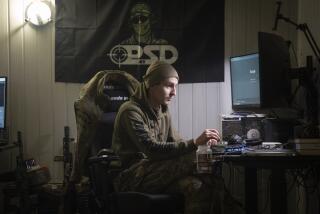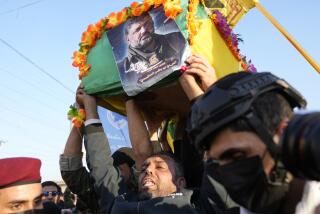U.S. Adopts New Tactics to Counter Iraqi Foes
- Share via
BALAD, Iraq — Facing stubborn, guerrilla-style resistance, the U.S. military is shifting tactics: It is trading the conventional warfare it used to oust Saddam Hussein for a campaign of swifter, more nimble strikes.
The military is also seeking to improve its intelligence-gathering and shift routine security tasks to Iraqis while accelerating efforts to win the hearts and minds of an edgy civilian population.
The goal of the counterinsurgency strategy is to confront and destroy an elusive enemy whose persistent attacks have impeded troop and supply movements and slowed national reconstruction.
The U.S. military is trying to be smarter, aiming to eliminate the armed cells in assaults featuring overwhelming might and advanced technology -- while at the same time reinforcing vital supply routes, communication lines and logistics centers.
“We have to deny the enemy sanctuary,” said Col. Frederick Rudesheim, an infantry brigade commander who led a large-scale assault last week on a suspected guerrilla safe haven near Tikrit. “Unless we get this under control, there is fertile ground for external influence.”
Commanders throughout Iraq have scrapped heavy-handed search tactics to mollify complaints and are handing out soccer balls and candy to children. The military is directing millions of dollars toward Iraq’s reconstruction, providing jobs to destitute young men who, officers fear, might otherwise be recruited to take up arms.
“I figure if someone has their stomach full and can feed their family, they’re less likely to go out there and try and kill young Americans,” said Lt. Col. Nate Sassaman, a former quarterback at West Point who heads an infantry battalion based in Balad, north of Baghdad.
Some military officials speak of “Iraqization” of the conflict, evoking America’s “Vietnamization” campaign more than three decades ago, under which the U.S. military gradually transferred responsibility for prosecuting the Vietnam War to the South Vietnamese.
But officials point to what they say are decisive differences: The armed opposition in Iraq has very limited popular backing, U.S. officials say, and there is no evidence of a national network directing the attacks.
“We’re using Vietnam-type tactics, but I don’t see a real guerrilla war in Iraq,” said Capt. Todd Brown, who was leading a platoon in the assault. “There’s just not that level of organization, of national hierarchy or popular support for the enemy.”
Nonetheless, the daily attacks against coalition troops -- combined with acts of sabotage and large-scale, lethal car bombings -- have clearly exacerbated a climate of instability and sapped the morale of weary soldiers.
Whether the new tactics are slowing the number of daily attacks is not clear. Even harder to gauge is whether the U.S. can prevent major bombings, which are almost impossible to eliminate and can have significant political repercussions, as experience across the Middle East has shown.
U.S. troops came to Iraq to fight a conventional war featuring tanks, heavy artillery, fighter planes and all the other trappings of large-scale, modern conflict. The aftermath was widely expected to be no more than a mop-up operation. But today the U.S. military finds itself embroiled in a draining struggle that demands alternative tactics, different equipment and a distinct brand of soldiering.
As of last week, 287 U.S. soldiers had been killed in the Iraq war and more than 1,110 had been wounded. More than half of the American troop deaths occurred after President Bush declared an end to major combat May 1.
“Tanks are great for destroying stuff, but you can’t completely destroy a place you’re supposed to rebuild and protect,” Sassaman said.
In fact, tank guns and howitzers are seldom fired here and serve largely as barriers at the many U.S. Army checkpoints.
The steady assaults on U.S. convoys have slowed down troop mobility in the so-called Sunni Triangle, the heartland of central and western Iraq that was the principal base of support for Saddam Hussein. The U.S. Army does not own the roads here. Large convoys now regularly receive protective air cover.
Combat units have been repositioned to provide protection for essential supply, communication and logistics posts, like the giant military airfield near Balad, called Anaconda, on the site of a former regime airbase. The enemy employs a textbook guerrilla tactic: hit rear-guard areas, which have relatively little protection.
“The enemy tends to flow where we’re not,” said Rudesheim, who heads the 3rd Combat Brigade of the 4th Infantry Division.
Commanders have been forced to spend long hours combing prospective convoy routes for now-notorious improvised explosive devices -- homemade bombs fashioned from artillery shells, grenades, mortar rounds and other explosives that have struck with devastating force, producing many U.S. casualties.
“Before I do an operation now, I have to go down and clear the whole route with an armored vehicle,” Capt. James Dayhoff said in Fallouja, west of Baghdad and a hotbed of resistance since the early days of the conflict.
“We’re more on the defensive now,” Dayhoff said. “We’re in a more ‘protect ourselves’ mode.”
Troops also spend time clearing brush along the major roadways that typically follow the routes of the Tigris and Euphrates river valleys, where lush stands of bulrushes and other vegetation provide potential ambushers with ideal cover.
“The other side tends to use the terrain quite well,” Staff Sgt. Johnny Johnson, master gunner on a convoy near Samarra, said as he cradled his black M-16 and peered intently through his shades at the dense stands of reeds. “We tend to make a lot of noise. They know we’re coming.”
Meanwhile, the daily routine of policing this occupied nation is increasingly being left to an array of new Iraqi security forces who accompany U.S. troops on patrols, guard duties and searches.
U.S. forces are now noticeably absent in the centers of large towns and cities, including those in the Sunni Triangle, where armed resistance is stiffest.
The shift -- gaining impetus as new Iraqi civil defense forces, guard units, a border patrol, army and even U.S.-style neighborhood watch groups come on board -- is by design.
“We want to pull the coalition forces to the outskirts of the cities, minimize our presence, still conduct periodic patrols, but hand over as much of that responsibility to Iraqi security forces as they can handle,” Lt. Gen. Ricardo Sanchez, the U.S. commanding officer in Iraq, told reporters recently. “Reduce our footprint. That’s our goal.”
The revised strategy has helped curb confrontations between U.S. troops and angry Iraqis that produced many civilian casualties early on, souring relations.
“We want to be sure that every operation we conduct doesn’t create more enemies than it takes off the streets,” said Maj. Gen. David H. Petraeus, who commands the Mosul-based 101st Airborne Division. “We try to be very precise in our operations now. Rather than doing dragnet operations, we try to have a bit more precision.”
In another bow to concerns from Iraqis, the U.S. side has modified its controversial “dynamic entry” search tactics, which involved breaking down doors, screaming orders at terrified civilians and pointing weapons at everyone inside. Iraqis often spoke of the humiliation of soldiers placing their boots on suspects’ heads.
Today, soldiers are instructed in “knock and talk” techniques, beginning with encircling targeted structures to ensure that no one escapes. Troops are instructed to request permission to enter, which is usually granted, commanders say. Metal-detecting wands are now used to check women for weapons; bags of money found in homes are placed in women’s possession as the searches proceed, to counter widespread charges of theft by GIs.
“We’re not hesitant about blowing doors down,” Petraeus said. “But we only do that when we’re absolutely sure that there’s a hostile target inside, and it’s necessary to do that.”
The adjustments have forced a distinct change in approach for individual soldiers, most of whom motored up from Kuwait on an adrenaline-rush cocktail from fierce firefights alternating with rapid advances.
“We’re used to big machinery, big guns,” noted Maj. Paul Green in Fallouja. “We’re not used to saying, ‘How are you? Do you mind if we have a little look?’ ... When a guy is used to pulling a lanyard on a howitzer, and now you’re telling him to maintain a traffic control checkpoint, it’s quite different.”
Soldiers in Iraq view the enemy as deadly serious, despite word from the high command that the armed opposition is scattered Baath Party remnants or small bands of pro-Hussein Fedayeen paramilitaries. To hear the grunts tell it, their foes are wily combatants who have utilized classic partisan techniques to sidetrack for the time being the world’s greatest military power.
“It’s the invisible enemy,” said Spc. Richard Almaraz, an infantryman from Gardena. “The mortars come into the base. We go and look for the people who fired them. And they just melt away.”
Soldiers speak of an increasing sophistication in today’s attacks, compared with the amateurish ambushes earlier in the conflict that inevitably ended with the enemy being killed by return fire. Attackers now often distract soldiers with improvised bombs before opening fire from strategic points that allow for safe retreats.
“In the beginning, they were just running around out there with weapons and didn’t seem to know where to go,” said Spc. Jason Testa, from New Jersey. “Now they’re consolidated, they get together with more people.... It’s scary out there. You don’t know when you’re going to get hit.”
Frustrated by the attacks, some commanders are denying much-needed economic aid to zones where attacks have been mounted, urging local sheiks and political leaders to turn in assailants or put pressure on them to stop.
“I’ve told the mayor and the sheiks, ‘I’ll support what priorities you want to fix in your towns and cities, providing they’re in areas where we’re not getting attacked,’ ” said Lt. Col. Christopher Hickey in Fallouja, where both bomb attacks and Fedayeen-style ambushes with rocket-propelled grenades, or RPGs, have repeatedly targeted U.S. forces. “If we’re getting attacked in certain areas, I will not help them in those areas.”
Typically, commanders say, sheiks and other leaders confronted about aggression blame unspecified “outsiders.” U.S. military authorities say they are not easily buying the excuse and are pressuring sheiks and others to inform on the enemy.
“Eleven guys don’t just show up with RPGs and machine guns without someone knowing about it,” Hickey said, referring to a recent ambush involving almost a dozen attackers.
Commanders’ oft-stated priority is to capture or kill the insurgents, especially the leaders and funders. Attackers taken into custody, wounded or killed tend to be lower-level operatives paid for their efforts but unable to lead authorities to insurgency leaders. Improved intelligence is essential, military leaders agree.
“Everything is intelligence-driven at this point,” Petraeus said. “You have to be able to identify the structure of who is out there and who their leaders are; what their support system is; where their weapons caches are; who’s funding them.”
There is no shortage of raw intelligence flowing into military bases, though much of it is useless or deliberately misleading.
In one recent case, an officer recalled, the Army mounted a raid on a middle-class family’s house northwest of Baghdad after an informant denounced a male occupant as a Baath loyalist. An armored vehicle climbed the home’s marble stairs and buckled the walls. The man was found to be innocent, and the U.S. government paid more than $20,000 in compensation.
“This,” Petraeus said, “is a culture of denunciation.”
Times staff writers Tracy Wilkinson in Baghdad and Jeffrey Fleishman in Najaf, Iraq, contributed to this report.
More to Read
Sign up for Essential California
The most important California stories and recommendations in your inbox every morning.
You may occasionally receive promotional content from the Los Angeles Times.













